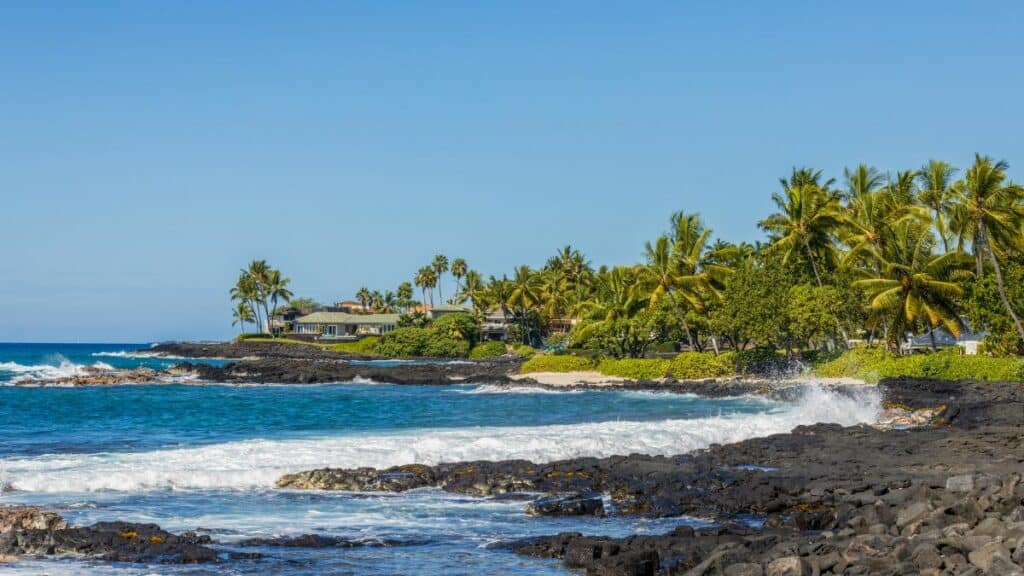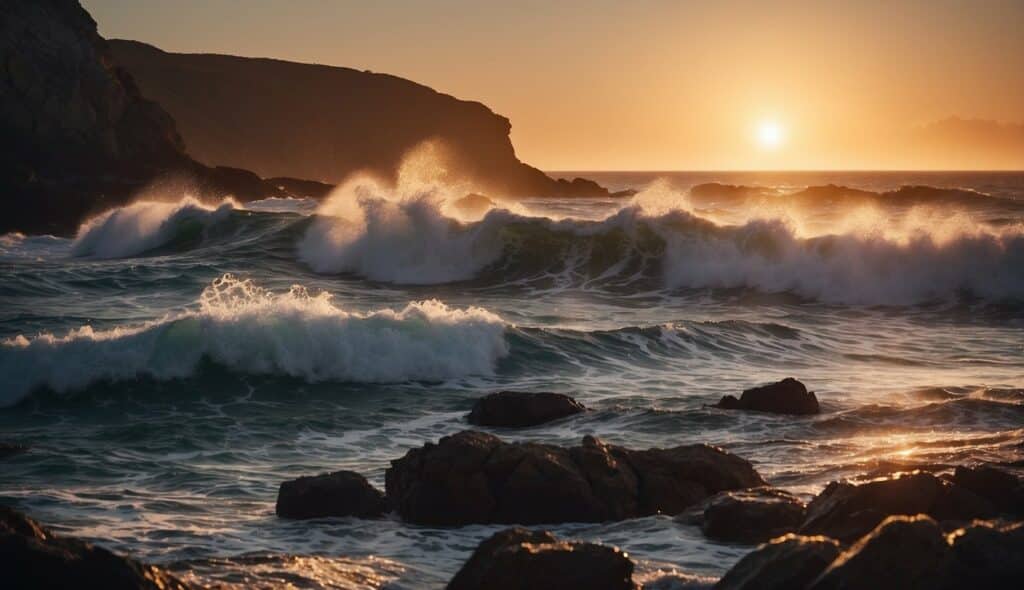Hawaii offers a unique shore fishing experience with its crystal-clear waters and abundant marine life. The state’s stunning beaches and rocky shorelines provide the perfect backdrop for anglers of all levels seeking to reel in a variety of fish species. Whether you’re a seasoned fisherman or new to the sport, you’ll find that the shores of Hawaii present an inviting challenge with the promise of an impressive catch. Before casting your line, be mindful of local regulations and protected areas to ensure your fishing adventure respects the natural habitat and cultural significance of the island’s fishing practices. Many areas are open to fishing, but it’s always wise to check for signage indicating any restrictions. With its diverse fish populations and breathtaking fishing spots, shore fishing in Hawaii isn’t just an activity—it’s an integral part of the island’s cultural fabric, harmoniously blending tradition with recreation.
Hanauma Bay
Hanauma Bay offers you a unique shore fishing experience on the southeast coast of Oahu. As a marine life conservation area and state underwater park, this bay is regulated to preserve its diverse ecosystem. Fishing in Hanauma Bay requires compliance with specific rules to protect its wildlife.
- Species to Target: You can expect to find a variety of fish in this underwater wonderland, including:
- Uhu (parrotfish)
- Kala (unicornfish)
- Roi (peacock grouper)
It’s important for you to be aware of the jellyfish presence, especially 9-10 days after the full moon, as box jellyfish are more plentiful during this period. In case of a sting, symptoms may include a burning sensation, redness, and possible swelling.
Before you start fishing, ensure you’re not in a no-fishing zone by looking for any signs indicating restrictions. Always stay informed about the local guidelines to avoid penalties.
- Gear Tips:
- Use light to medium tackle for responsiveness and control
- Select appropriate lures and bait for the targeted species
Kaena Point
On Oahu’s northwest shore, Kaena Point stands out as a notable destination for shoreline fishing enthusiasts like you. With its significant deep-water proximity, it’s a place where considerable catches, such as the giant trevally (ulua), are more than just fish tales. To capitalize on these opportunities, here’s what you need to know:
- Location & Access: Reaching Kaena Point requires a bit of a hike. Make sure to bring necessary supplies as amenities are limited.
- Target Species: The coveted ulua is frequently sought after here, but you may also hook other species like papio.
Tips for Successful Fishing:
- Timing: Arrive early morning or late afternoon for the best bite, considering both the tide and the season.
- Gear: Use appropriate tackle for the potentially large fish you aim to catch.
- Regulations: Stay informed about the fishing regulations to ensure a responsible and legal fishing trip.
Safety Reminder: The coastline can be rugged; take caution while navigating the terrain.
By respecting the area’s natural beauty and wildlife, you can enjoy a serene yet potentially rewarding fishing experience. Whether you cast from the sandy shores or rocky outcrops, Kaena Point offers a unique fishing venture.
Kee Beach
At the northernmost tip of Kauai’s roads, you’ll find Kee Beach, a picturesque spot ideal for shore fishing. Surrounded by lush tropical forest and the beginning of the famous Napali Coast, Kee Beach is not only a stunning location but also offers fruitful fishing opportunities.
The protective reef at Kee Beach creates a tranquil lagoon, making it a generally safe place for you to enjoy snorkeling and swimming. However, it is crucial to be aware of the ocean conditions as during the winter months, the surf can rise significantly over the reef, increasing the risk for swimmers and affecting fishing conditions.
Fishing Tips:
- Avoid the reef channel on the west end, as strong currents there could be hazardous.
- Optimal Seasons: Consider visiting outside of winter for the calmest conditions.
- Gear: Light to medium action rods suitable for the variety of fish you might encounter.
Target Species:
- Moi (Pacific threadfin)
- Menpachi (soldierfish)
- Awa (milkfish)
When you plan your fishing trip to Kee Beach, remember to respect the local wildlife and the serene environment. Should you decide to venture into the water, stay alert to the changing ocean conditions to ensure a safe and enjoyable experience. This special location offers more than just fishing; it’s a gateway to the grandeur of Hawaii’s natural beauty.
Kapalua Bay

Kapalua Bay, situated on the northwest coast of Maui, is an exquisite spot for shore fishing. When you arrive, you’ll notice the crescent-shaped beach, clear waters, and a protective cove which contributes to consistently good fishing conditions.
Location:
Kapalua Bay, Maui, HI 96761
Fishing Conditions:
- Calm waters due to natural cove protection
- Presence of coral, which attracts diverse fish species
What You Might Catch:
- Parrotfish
- Triggerfish
- Wrasses
Gear Recommendations:
- Use medium spinning gear for versatile fishing.
- Artificial lures and natural baits like sand worms are effective.
When you cast your line in Kapalua Bay, your patience may be rewarded with some of the local aquatic life that thrives in these inviting waters. Keep in mind that shoreline fishing in Hawaii respects local customs and regulations to ensure that this pastime remains sustainable for years to come.
Make sure to check for any temporary closures or specific area regulations before you plan your fishing trip. Don’t forget to bring your fishing essentials and enjoy the natural beauty and serenity of Kapalua Bay.
South Point
South Point, also known as Ka Lae, is in Hawaii and holds the distinction of being the southernmost point in the United States. As a shore fishing enthusiast, you’ll find this location appealing due to its unique fishing opportunities.
When you make your way to South Point, prepare for a fishing experience highlighted by the potential for significant catches. The waters are known for ulua (giant trevally), which can be quite large in this area, with some near-record setting catches reported at nearly 100 pounds. Other species such as bonefish and papio are also common, providing a diverse fishing experience.
Getting There:
- Take Highway 11 to the turnoff for South Point Road between the 69 and 70 mile markers.
- Drive approximately six miles south on a narrow, two-lane road.
- The road traverses through macadamia nut groves and lava flows, offering a scenic journey to the fishing destination.
What to Expect:
- Unique Fishing Spot: Experience fishing from the southernmost point of the U.S.
- Variety of Fish: Ulua, bonefish, and papio are amongst the species you might catch.
- Scenic Views: Macadamia groves and lava fields provide a beautiful backdrop.
Tips for Success:
- Pack accordingly: Bring snacks, water, and sunscreen for your trip.
- Safety first: The winds can be strong, and the rocks slippery, so exercise caution.
- Gear up: Use appropriate tackle for the larger fish species found at South Point.
Remember to respect the land and local customs, as South Point is not only a great fishing spot but also a place of cultural significance for native Hawaiians.
Hapuna Beach
Hapuna Beach, located on Hawaii’s Big Island, is recognized for its expansive, white sandy shores and clear, blue waters. This destination is not only ideal for swimming and sunbathing, but also for your shore fishing adventures.
- Best Time to Visit: Visit during summer for optimal conditions, as the waters are known to be calmer.
- Facilities: You’ll appreciate the convenience of the available amenities, such as picnic areas and restrooms.
Fishing Tips:
- Focus on mornings or evenings for a more productive fishing experience.
- Use local bait, as it tends to attract more fish.
In summer, the tranquil waters can provide a soothing fishing experience, but you should be mindful of the occasional rough waves. Although these waves are typically enjoyed by experienced surfers, they can also influence the behavior of fish near the shore.
Species You Might Catch:
- Moi (Pacific threadfin)
- Menpachi (soldierfish)
- Awa (milkfish)
Hapuna Beach also has a role in conservation and education about local culture and natural resources. Ensure that you’re aware of any regulations regarding fishing limits and protected species to maintain the beach’s ecological balance.
Admission:
- Hawaii Residents: Free with a valid ID
- Non-Residents: A fee is applicable
By respecting the area’s guidelines and enjoying the serene backdrop, your fishing experience at Hapuna Beach can be both successful and environmentally conscious.
Molokai’s East End

Molokai’s East End is recognized for its tranquil and undisturbed shorelines, making it an idyllic spot for fishing enthusiasts like you. The area is notably devoid of the typical tourist bustle, allowing for a serene fishing experience.
Best Spots for Fishing:
- Kaunakakai Pier: The longest wharf in Hawaii, offering both deep sea and shore fishing opportunities.
- Keawanui Fishpond: A restored ancient fishpond providing insight into traditional Hawaiian aquaculture.
When visiting the East End for fishing, you can expect to encounter a variety of fish species. Here’s what you might find on your line:
Common Fish Species:
- Marlin: Highly sought after for their sports fishing qualities.
- Mahimahi: Known for their fight and delicious taste.
- Ahi (Yellowfin Tuna): Often found in deeper waters, prized for sushi and sashimi.
- ʻOno (Wahoo): A fast-swimming fish, challenging and rewarding to catch.
For an optimal fishing experience, it’s crucial to consider the kind of bait you use. Local wisdom suggests the following baits to increase your chances of a catch:
Effective Bait:
- Squid: Versatile and appealing to various fish species.
- Crabs: An excellent choice for bottom-dwelling fish.
- Minnows: Imitate small fish that larger species feed on.
Each species demands a unique approach. Consult with local anglers or guides who can provide you with the nuances of fishing on Molokai’s East End. Their expertise will enhance your chances of a memorable catch.
Poipu Beach Park
Location: Located on the south shore of Kauai, Poipu Beach Park is a renowned destination for shore fishing enthusiasts.
Fish Species: Common targets include:
- Bonefish
- Ulua
- Other coastal species
Fishing Tips:
- Early morning or late afternoon are typically the best times for fishing.
- Be sure to bring your own rod and tackle.
- Local regulations encourage catch and release to preserve fish populations.
Amenities at Poipu Beach Park:
- Parking
- Lifeguard services available seven days a week
- Restrooms and showers
- Picnic tables for comfortable breaks between fishing sessions
Remember, while fishing, you might witness Hawaiian monk seal appearances, a highlight of the natural beauty and biodiversity of the area. Maintain a respectful distance from any wildlife you encounter. Enjoy your fishing experience at Poipu Beach Park with its crystal-clear waters and picturesque views.
Kiholo Bay
Located on the Big Island of Hawaii, Kiholo Bay beckons with its sparkling turquoise waters and quiet coves. This bay is particularly notable as a fly fishing haven where you can target a variety of fish species.
- Target Species:
- Bonefish
- Trevally
- Occasional Barracuda
The bay’s geography allows you the opportunity to wade and cast along the shoreline, which can enhance your fishing experience with the intimate connection to the environment.
Best Practices:
- Always be mindful of local regulations and obtain the necessary permits.
- Practice catch and release to preserve the fish population.
- Respect the natural habitat by minimizing your impact on the environment.
Being well-prepared with the right gear and knowledge will maximize your enjoyment and success in Kiholo Bay.
Makaha Beach
Located on O’ahu’s leeward coast, Makaha Beach is a prime spot for shore fishing enthusiasts. With its backdrop of rugged mountains and clear blue waters, it not only offers picturesque scenery but also a rewarding fishing experience.
Species:
Makaha Beach is notable for its diverse range of fish species. You have the chance to catch:
- Ulua (Giant Trevally)
- Papio (Juvenile Trevally)
- Bonefish
Fishing Conditions:
You’re greeted by a sweeping sandy shore that slopes into the Pacific. However, be mindful of the sandbar that creates strong backwash, which can be challenging for both fishing and swimming.
Amenities:
When you visit, you’ll find the following facilities to make your trip more comfortable:
- Parking
- Restrooms
- Showers
- Lifeguard services
Remember that Makaha Beach is also known for its surfing history, so you’ll want to be aware of other water activities in the area. Ensure you maintain a safe distance from swimmers and surfers to avoid any interference.
Fishing Techniques:
- Use live bait or lures for Ulua.
- Opt for smaller bait for Papio.
- For Bonefish, light tackle is effective.
For the optimal fishing experience at Makaha Beach, come prepared with the right gear, check the local fishing regulations, and be respectful of the area’s natural beauty and other visitors. Whether you’re a seasoned angler or trying shore fishing for the first time, Makaha Beach could be your next favorite fishing destination.
Techniques and Strategies
When embarking on shore fishing in Hawaii, various techniques can enhance your experience and success rate. Understanding and implementing the right strategies is essential to making the most out of your fishing excursion.
Dunking
Dunking, a prevalent method, involves casting baited lines and letting them settle on the sea floor. It’s particularly effective for stationary fish. Be sure to use a heavy enough weight to keep your bait in one spot, which will prove invaluable when targeting species like the moi or ulua.
Whipping
Whipping is another widespread technique involving casting and retrieving a lure to mimic injured prey. Short, quick motions of your rod—snappy and rhythmic—are best to entice predators. Whipping is ideal for trevally, commonly known as papio or ulua, depending on the size.
Prepare your tackle
- Specific fish require different setups
- Balance weights for dunking
- Choose lures for whipping based on target species
Master your technique
- Practice casting for accuracy and distance
- Get to know the motions for whipping
- Learn safe spearfishing practices
Read the environment
- Always observe tides and currents
- Reef and sandy bottoms may dictate the appropriate strategy
Essential Gear and Equipment
Having the right gear and equipment is crucial for a successful and enjoyable shore fishing experience in Hawaii. You will need to focus on the type of rod and the bait or lures you select based on the local fish species.
Choosing the Right Fishing Rod
Rod Length: Select a surf rod between 7 and 12 feet in length to ensure you can cast long distances from the shore and manage the fight with some of the robust Hawaiian fish species.
Rod Action: Opt for a medium to heavy action rod which will give you the versatility to handle various fish sizes, from small reef fish to larger game species like trevally.
Selecting the Appropriate Bait and Lures
Bait:
- Live Bait: Using live bait such as small shrimp or smaller fish can be effective, especially for predators like snapper or trevally that are enticed by the movement.
- Jigs: These can mimic an injured fish and are particularly useful for bottom-dwelling species. A variety of sizes and colors allows you to target specific fish more efficiently.
Lures:
- Use surface poppers for an exciting top-water action which proves enticing for larger species.
- Experiment with spoon lures, which are effective for their reflective surface and erratic movement, thus attracting a range of species.
Remember to pair your bait and lures with the appropriate size and strength of hooks to ensure the best chance of securing your catch.
Targeted Fish Species

Exploring Hawaii’s rich marine life spots you in the center of a diverse angling adventure targeting some of the most revered fish in the world. Your experience can range from coastal catches to battling big game species.
Catching the Elusive Ulua
Ulua (Giant Trevally), often the prize catch among shore anglers, is renowned for its size and fight. You can find juvenile Ulua (Papio) in shallower waters, but for larger Ulua, deep rock ledges or high surf areas might yield success. Consider robust gear, as Ulula can grow over 100 pounds.
- Common Techniques: Live bait, slide bait, or whipping
- Best Locations: Punaluu Black Sand Beach, Whittington Beach Park
- Preferred Baits: Squid, crab, octopus
Hunting Bonefish and Trevally
With Hawaii’s clear, shallow flats, you have the opportunity to stalk and sight-cast to Bonefish and Trevally (Oio and Papio). These saltwater species provide an exhilarating challenge with their swift runs and stamina.
Bonefish (Oio)
- Size: Average 1-5 pounds
- Tactics: Fly fishing, light-tackle spinnin
Trevally (Papio/Awa/Ahi)
- Varieties: Bluefin Trevally, Bigeye Trevally, Golden Trevally
- Size: Can range up to 20 pounds or more for certain species
- Tactics: Popping, jigging
- Common Locations: Hilo Bayfront, Puako
Anglers can also encounter other species such as Yellowfin Tuna (Ahi), Barracuda, Snapper, and various kinds of Reef Fish like Parrotfish and Surgeonfish while targeting the primary species. Each fish demands specific techniques, gear, and baits, catering to a wide range of angling preferences and skills.
Meet Nic Armitage, a devoted outdoors enthusiast with an insatiable love for fishing, boating, and a wide range of adventurous activities. His passion for the great outdoors knows no bounds. Nic is your trusted guide into the world of nature, sharing his experiences and expertise on the Shaman Mountain Sports and Outdoors Blog.





